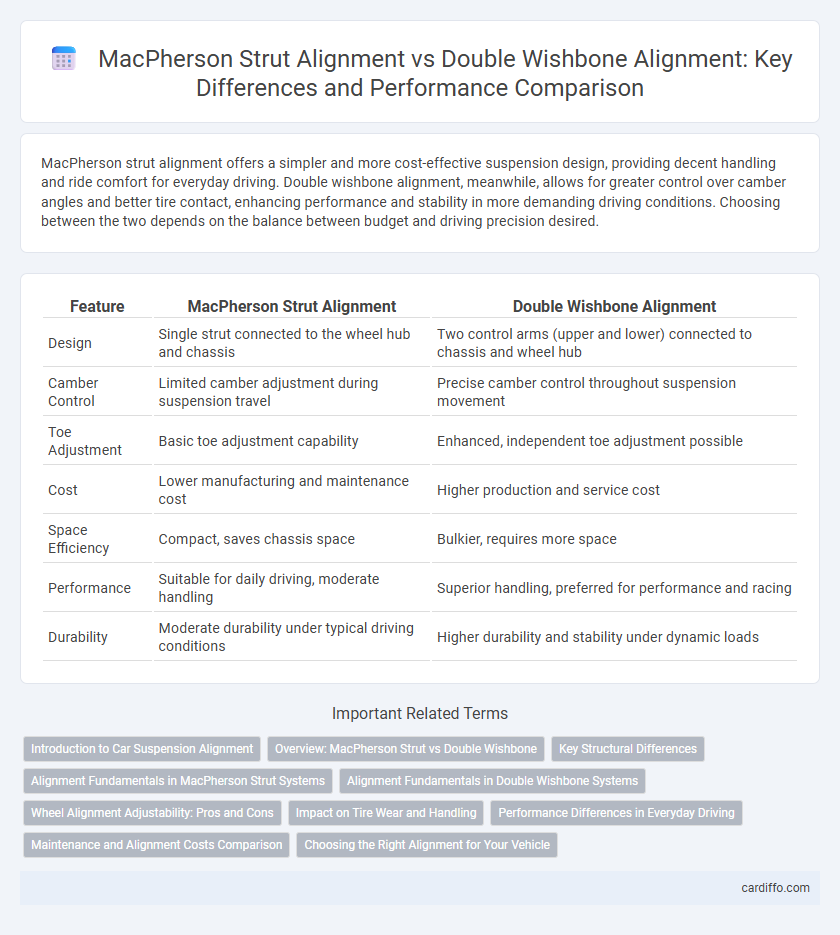MacPherson strut alignment offers a simpler and more cost-effective suspension design, providing decent handling and ride comfort for everyday driving. Double wishbone alignment, meanwhile, allows for greater control over camber angles and better tire contact, enhancing performance and stability in more demanding driving conditions. Choosing between the two depends on the balance between budget and driving precision desired.
Table of Comparison
| Feature | MacPherson Strut Alignment | Double Wishbone Alignment |
|---|---|---|
| Design | Single strut connected to the wheel hub and chassis | Two control arms (upper and lower) connected to chassis and wheel hub |
| Camber Control | Limited camber adjustment during suspension travel | Precise camber control throughout suspension movement |
| Toe Adjustment | Basic toe adjustment capability | Enhanced, independent toe adjustment possible |
| Cost | Lower manufacturing and maintenance cost | Higher production and service cost |
| Space Efficiency | Compact, saves chassis space | Bulkier, requires more space |
| Performance | Suitable for daily driving, moderate handling | Superior handling, preferred for performance and racing |
| Durability | Moderate durability under typical driving conditions | Higher durability and stability under dynamic loads |
Introduction to Car Suspension Alignment
MacPherson strut alignment typically requires adjusting camber, caster, and toe angles to ensure optimal tire contact and handling performance. Double wishbone alignment provides greater control over camber changes during suspension travel, allowing for more precise alignment settings and improved stability. Proper suspension alignment reduces tire wear, enhances steering response, and maintains vehicle safety across both MacPherson strut and double wishbone systems.
Overview: MacPherson Strut vs Double Wishbone
MacPherson strut alignment offers simplicity and cost-effectiveness, utilizing a single control arm that combines the shock absorber and coil spring assembly, promoting compact design in front suspensions. Double wishbone alignment provides superior handling and wheel control through two separate control arms that maintain optimal tire contact with the road, enhancing stability and cornering performance. Vehicle manufacturers select MacPherson strut setups for economy and packaging efficiency, while double wishbone systems are favored in performance and luxury vehicles for their precise alignment adaptability.
Key Structural Differences
MacPherson strut alignment features a single lower control arm combined with a strut assembly that integrates the shock absorber and coil spring, allowing for a compact and lightweight suspension design. Double wishbone alignment uses two parallel control arms (upper and lower) to provide greater control over camber angles and wheel motion, resulting in improved handling precision and tire contact. The key structural difference lies in the MacPherson's simpler, vertically-oriented strut assembly versus the double wishbone's more complex, dual-arm setup that enables enhanced suspension geometry adjustment.
Alignment Fundamentals in MacPherson Strut Systems
MacPherson strut alignment fundamentally affects camber, caster, and toe angles, which are critical for vehicle stability and tire wear. The strut design integrates the shock absorber and coil spring into a single assembly, requiring precise top strut mount adjustments to maintain correct caster and camber. Unlike double wishbone systems that allow independent control of suspension geometry, MacPherson strut alignment optimization relies heavily on the precise positioning of lower control arms and strut mounts to ensure optimal wheel alignment and handling performance.
Alignment Fundamentals in Double Wishbone Systems
Double wishbone suspension systems provide superior camber control compared to MacPherson struts, enabling more precise alignment adjustments that enhance tire contact and handling performance. The independent movement of the upper and lower arms allows for optimized caster, camber, and toe settings, maintaining stability and minimizing tire wear under dynamic driving conditions. This precise control is fundamental to achieving ideal wheel alignment, ensuring improved vehicle responsiveness and longevity.
Wheel Alignment Adjustability: Pros and Cons
MacPherson strut alignment offers simpler and more cost-effective adjustments mainly in camber and caster, but limited toe adjustment flexibility compared to double wishbone systems. Double wishbone alignment provides superior adjustability across camber, caster, and toe angles, enabling precise tuning for better handling and tire wear optimization. However, the complexity of double wishbone alignment increases service time and cost, requiring specialized knowledge and equipment.
Impact on Tire Wear and Handling
MacPherson strut alignment typically results in increased tire wear due to its simpler design and limited camber control, leading to uneven tire contact during cornering. Double wishbone alignment offers superior handling by maintaining optimal tire contact patch and improved camber control, which reduces tire wear and enhances vehicle stability. The enhanced adjustability of double wishbone setups provides better performance in dynamic driving conditions, minimizing tire degradation and improving overall road grip.
Performance Differences in Everyday Driving
MacPherson strut alignment offers a simpler design that provides adequate handling and comfort for everyday driving, excelling in compact and mid-sized vehicles due to its cost-effectiveness and space efficiency. Double wishbone alignment, with its independent suspension control, delivers superior handling precision, improved tire contact, and better stability during cornering, making it ideal for performance-oriented vehicles. While MacPherson struts prioritize ride comfort and manufacturing economy, double wishbones offer enhanced alignment consistency and responsiveness under dynamic driving conditions.
Maintenance and Alignment Costs Comparison
MacPherson strut alignment generally incurs lower maintenance and alignment costs due to its simpler design and fewer components compared to double wishbone suspension. Double wishbone systems, while offering superior handling and adjustability, require more frequent and precise alignment adjustments, leading to higher service expenses. The increased complexity and additional parts in double wishbone suspension elevate both labor time and the potential need for specialized equipment during alignment procedures.
Choosing the Right Alignment for Your Vehicle
Choosing the right alignment for your vehicle depends on the suspension type: MacPherson strut or double wishbone. MacPherson strut alignment prioritizes simplicity and cost-effectiveness, commonly used in front-wheel-drive cars, optimizing camber and caster angles for improved fuel efficiency and tire wear. Double wishbone alignment offers enhanced handling precision and stability, ideal for performance vehicles, by independently adjusting camber, caster, and toe angles to maximize tire contact during cornering.
MacPherson strut alignment vs double wishbone alignment Infographic

 cardiffo.com
cardiffo.com